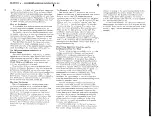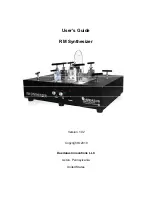
PROGRAMMING VOICES: A TUTORIAL
ence whether the envelope had reached LEVEL 3 and
was sustaining, had just reached LEVEL 2, or had not
yet reached LEVEL 1. Whatever the level when you
release the key, the sound immediately moves toward
LEVEL 4 at RATE 4. At the slowest setting for RATE 4,
the sound can linger for so long that you think the note
is stuck (up to 3 minutes). Typically LEVEL 4 is set at
zero (minimum or "off") so that the note eventually turns
off. RATE 4 is analogous to the release time in a stand-
ard ADSR.
A major advantage of the DX7 envelope is that each
of the 8 parameters can be set to any of 100 values, pro-
viding precision and repeatability The maximum value
of each LEVEL setting is 99, with a minimum value of
zero (off). Similarly, the maximum rate is also 99 (fastest
change in level). Mathematically, this works out to pro-
vide something over 1,000,000,000,000,000 different
envelopes (that's right, 15 zeroes!).
NOTE: If you program a carrier envelope so LEVEL 4
is greater than 0, the sound will not die. If you pro-
gram RATE 4 at or new 0, the sound will seem to last
"forever" Even if you then reset LEVEL 4 to 0 and
RATE 1 to 99, the sound will continue until you play
16 notes, the 16th note cancels the last "lingering" note
that was programmed with the previous settings.
Two basic approaches to creating your
own sounds on the DX7.
There are two basic approaches to programming the
DX7. First, you can run through all the available preset
voices, choose one that is close to the sound you want,
and then edit that voice to create the sound you want.
Second, you can "initialize" the editing buffer of the DX7
and create a voice "from scratch," one that does not rely
at all upon any previously created voice.
The first method, editing a preset voice, is generally a
much more efficient approach, provided the sound you
want is close to something that already exists. (We don't
mean to say that you can't edit an existing voice into
something radically different, but the knowledge and
effort required to do that in a predictable fashion are
formidable.) If you are looking for a unique voice that is
totally unlike any preset, it is probably best to start "from
scratch." The decision about which approach to use will
become easier as you gain experience with the DX7.
Initially we urge you to read this section and follow
instructions carefully as we give you a "guided tour" of
the DX7 and show you how to program a voice "from
scratch." This may seem more difficult, but it is actually
a much better way for you to learn how each of the
editing parameters (functions) really works. In the begin-
ning, it may seem almost overwhelming due to the
unfamiliar terminology and technology. However, as you
become familiar with the instrument and gain a working
knowledge of envelopes, frequency ratios, keyboard
scaling, and so forth, you'll find creating a voice "from
scratch" will become much easier, and editing an exist-
ing voice (a preset or one of your own prior creations)
will become a fast, relatively simple process.
Programming a voice "from scratch"
In order to begin programming a voice "from scratch,"
you'll want to have a clear memory location so that
when you've completed working on the voice, you can
save it. Actually, any of the DX7 internal memories can
be used. Nothing is erased while you are creating a
voice, but when you're done and you store the new
voice in one of the memories, whatever voice had been
in that memory will be erased.
CAUTION If you are using the synthesizer after
someone else has been programming voices,
make sure those voices have first been stored
on a RAM cartridge before proceeding. Other-
wise you might accidentally "erase" or change
someone else's efforts.
In this section of the manual, we present information
in an order which should make it possible for you to
achieve immediate, audible and satisfying results as you
learn to program a voice. To aid in organization of the
information, we have used subheadings that often use
the name of the button, or that describe the use of sev-
eral buttons which, together, achieve the programming
function being discussed. Many of these subheads
include their own step-by-step instructions. We intention-
later review a single subhead and follow the steps for
programming that particular parameter. Once you have
become familiar with the DX7, there is no "rule" that
you have to follow this order. For now, however, please
read and follow these instructions as presented.
NOTE If you do jump ahead and "get lost" or should
you accidentally program one parameter when you
thought you were working on something else, an
"emergency bail out" is always available: return to the
[VOICE INIT] function presented here at Ihe beginning
of this section. Turning power off and on will NOT
reset your voice.
VOICE INITiaIization
When you want to program a voice "from scratch,"
you do it by initializing a voice. That is, regardless of
which voice you are currently playing, you reset all its
parameters to a starting point which is about the sim-
plest setting that will still produce a sound. This could
take many minutes of button pushing if you had to
manually check each programmable item. To save time,
you can instead use the [VOICE INIT] function.
Although you gain access to "Voice Initialize" from the
FUNCTION mode, the actual voice is not programmed
with the DX7 in FUNCTION mode. As soon as you have
performed the steps below to initialize the voice, the
DX7 is automatically placed in the EDIT mode, and then
the programming begins.
1. To gain access to the "Voice Initialize" function, press
[FUNCTION], and then [VOICE INIT], and answer
the displayed prompts.
27
ally restart with Step 1 for each subhead so that you can
Содержание Vintage DX7 Special Edition ROM
Страница 1: ...YAMAHA AUTHORIZED PRODUCT MANUAL DX7 DIGITALPROGRAMMABLE ALGORITHMSYNTHESIZER...
Страница 2: ...YAMAHA DigitalProgrammable Algorithm Synthesizer OPERATION MANUAL...
Страница 5: ......
Страница 70: ...YAMAHA VOICE DATA LIST...
Страница 71: ...DX7 OM 5 20 99 19E0112 international Corp Box 6600 Buena Park Calif 90622...










































